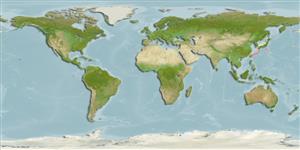>
Eupercaria/misc (Various families in series Eupercaria) >
Labridae (Wrasses) > Bodianinae
Etymology: Bodianus: Bodianus after Bodiano or Pudiano, from the Portuguese pudor, meaning modesty (Jordan & Evermann, 1896); thoracotaeniatus: Name from the combination of the masculine Greek noun 'thorakos' for breastplate, and
feminine Latin noun for ribbon, refers to its diagnostic filamentously prolonged pelvic-fin ray.
Environment: milieu / climate zone / depth range / distribution range
Écologie
marin récifal; profondeur 320 - 395 m (Ref. 75973). Temperate
Northwest Pacific: Kyushu-Palau Ridge.
Taille / Poids / Âge
Maturity: Lm ? range ? - ? cm
Max length : 14.8 cm SL mâle / non sexé; (Ref. 75973)
Description synthétique
Clés d'identification | Morphologie | Morphométrie
Épines dorsales (Total) : 12; Rayons mous dorsaux (Total) : 11. Distinguished morphologically by the following: D XII, 11; caudal fin rays 10 + 12 + 7-9; pectoral-fin rays ii, 15; lateral-line scales 29; scales above lateral line 2½; scales below lateral line 8-10; predorsal scales about 21-24; total gill rakers 15-16; anterior canines of similar size on upper jaw; dental ridge with 7-12 smaller posterior canines to anterior ones, last few sometimes smaller, coalesced at base and set apart from others; prominent canine at posterior end of jaw; lower jaw with first prominent anterior canine ?4?5 length of second; dental ridge with 2-3 consecutive series of smaller canines, first of 6-10 teeth, second with about 6-10 much smaller teeth sometimes separable into 2 groups, teeth confluent at base with acute tips; moderately deep body, 24.1-27.1% SL; moderately long snout (10.9-11.7% SL) and head (36.3-37.5% SL); pelvic fin with first soft ray faintly thicker and prolonged as filament, with tip reaching distinctly beyond anus, to base of third anal-fin ray in some (Ref. 75973).
Oviparous, distinct pairing during breeding (Ref. 205).
Life cycle and mating behavior
Maturité | Reproduction | Frai | Œufs | Fécondité | Larves
Oviparous, distinct pairing during breeding (Ref. 205).
Gomon, M.F., 2006. A revision of the labrid fish genus Bodianus with descriptions of eight new species. Rec. Aust. Mus. Suppl. 30:1-133. (Ref. 75973)
Statut dans la liste rouge de l'IUCN (Ref. 130435: Version 2024-1)
Menace pour l'homme
Harmless
Utilisations par l'homme
Outils
Articles particuliers
Télécharger en XML
Sources Internet
Estimates based on models
Preferred temperature (Ref.
123201): 3.5 - 5, mean 4.3 °C (based on 26 cells).
Phylogenetic diversity index (Ref.
82804): PD
50 = 0.5000 [Uniqueness, from 0.5 = low to 2.0 = high].
Bayesian length-weight: a=0.01230 (0.00569 - 0.02662), b=3.05 (2.87 - 3.23), in cm total length, based on LWR estimates for this Genus-body shape (Ref.
93245).
Niveau trophique (Ref.
69278): 3.4 ±0.5 se; based on size and trophs of closest relatives
Résilience (Ref.
120179): Haut, temps minimum de doublement de population inférieur à 15 mois (Preliminary K or Fecundity.).
Fishing Vulnerability (Ref.
59153): Low vulnerability (10 of 100).
